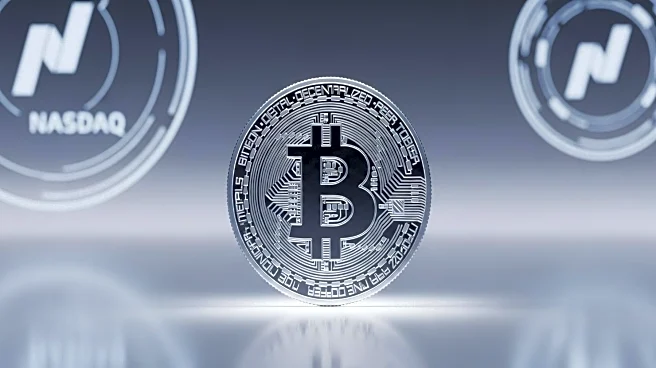What's Happening?
American Bitcoin Corp. (ABTC), a Bitcoin mining company backed by Eric and Donald Trump Jr., made its debut on the Nasdaq on September 3, 2025, following a merger with Gryphon Digital Mining. The stock experienced significant volatility, surging up to 91% to a high of $14 per share before dropping to a low of $6.72, ultimately closing at $8.05, up 16.5% for the day. Trading was halted five times due to sharp price swings, triggered by Nasdaq's circuit breaker mechanisms to manage volatility. The company, valued at approximately $5 billion, holds 2,443 BTC worth around $273 million. The debut reflects growing institutional interest in crypto firms, though concerns have been raised about potential conflicts of interest due to the Trump family's involvement and pro-Bitcoin policies.
Why It's Important?
ABTC's listing provides a regulated, publicly traded vehicle for institutional investors to gain exposure to Bitcoin without directly holding the asset. Its hybrid model, combining Bitcoin mining with opportunistic market purchases, offers a unique blend of operational and speculative exposure, distinct from spot ETFs or traditional miners. This democratizes access to Bitcoin's price dynamics and mining economics, appealing to investors wary of crypto's volatility or technical barriers. The company's scalability enhances its ability to increase Bitcoin per share through efficient mining and strategic purchases. However, scaling too rapidly could strain operational efficiency if energy costs or mining difficulty rise significantly. The Trump administration's pro-crypto policies, including the Strategic Bitcoin Reserve, reduce compliance burdens and enhance investor confidence, though political affiliations raise concerns about conflicts of interest.
What's Next?
ABTC plans to expand into markets like Hong Kong and Japan, potentially diversifying revenue streams and attracting global investors. However, this expansion introduces new compliance challenges in foreign markets, potentially complicating governance. The company's concentrated ownership ensures strategic alignment but raises governance concerns, with critics highlighting the risk of political influence or insider control. ABTC's ability to scale hinges on Hut 8's energy-efficient infrastructure and shared services, which reduce expenses and capital costs. Scaling mining operations with next-generation ASICs and expanding into low-cost energy markets could lower Bitcoin production costs, enhancing profitability and investor appeal. However, rising energy prices or supply chain disruptions for ASIC hardware could offset these gains, impacting margins.
Beyond the Headlines
ABTC's merger with Gryphon Digital Mining reflects a broader trend of consolidation in the crypto mining sector, where firms combine to achieve economies of scale and operational efficiency. ABTC's hybrid model positions it to compete with traditional miners and corporate Bitcoin holders, challenging the latter's dominance. Scaling mining capacity through Hut 8's infrastructure and expanding internationally could position ABTC as a top Bitcoin holder, but it must navigate rising competition and network difficulty. Transparent reporting and adherence to international regulations will be critical to sustaining scalability without triggering regulatory backlash.











